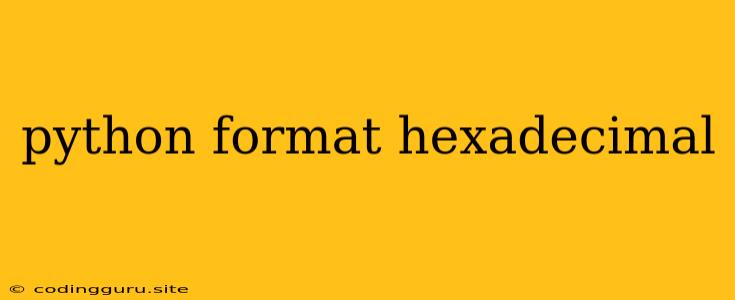Python Format Hexadecimal: A Comprehensive Guide
In the realm of programming, hexadecimal representation is a fundamental concept, particularly when working with data structures like memory addresses, color codes, or network protocols. Python, being a versatile language, provides various methods for formatting data into hexadecimal format, each tailored for specific situations. This comprehensive guide will delve into the different ways to format hexadecimal values in Python, empowering you to effectively manipulate and display data in this numerical system.
Understanding Hexadecimal
Hexadecimal, also known as "hex," utilizes base-16, representing numbers using digits 0-9 and letters A-F (A representing 10, B representing 11, and so on). This system proves efficient for representing binary data, as each hexadecimal digit corresponds to four binary digits (bits).
Python's Built-in Functions
Python offers several built-in functions that streamline hexadecimal formatting:
1. hex() Function
The hex() function takes an integer as input and returns a string representation of that integer in hexadecimal format. It includes the prefix "0x" by default.
Example:
decimal_number = 255
hexadecimal_number = hex(decimal_number)
print(hexadecimal_number) # Output: 0xff
2. format() Function
The format() function provides a versatile way to customize the formatting of various data types, including integers. Using the format specifier "x" for lowercase hex or "X" for uppercase hex, you can control the output:
Example:
decimal_number = 255
hexadecimal_number = format(decimal_number, 'x')
print(hexadecimal_number) # Output: ff
uppercase_hex = format(decimal_number, 'X')
print(uppercase_hex) # Output: FF
3. f-strings
Python's f-strings offer a clean and readable way to format data within strings. You can directly insert formatted hexadecimal values using the "x" or "X" specifiers:
Example:
decimal_number = 255
hexadecimal_string = f"The hexadecimal value of {decimal_number} is: {decimal_number:x}"
print(hexadecimal_string) # Output: The hexadecimal value of 255 is: ff
Converting from Hexadecimal to Decimal
While Python excels at converting decimal numbers to hexadecimal, you might also need to convert hexadecimal values back to their decimal representation. This is achieved using the built-in int() function with the base argument set to 16:
Example:
hexadecimal_string = "0xff"
decimal_number = int(hexadecimal_string, 16)
print(decimal_number) # Output: 255
Beyond Integers
The above methods primarily focus on formatting integers. However, hexadecimal representation is often employed with bytes and byte arrays. Python provides ways to work with these data types in hexadecimal format:
Bytes and Byte Arrays
Bytes and byte arrays store sequences of bytes, each byte represented by a number between 0 and 255. You can convert these sequences to hexadecimal using several approaches:
binascii.hexlify(): This function converts a byte sequence into a hexadecimal string.
Example:
import binascii
byte_data = b"\x01\x02\x03"
hex_data = binascii.hexlify(byte_data)
print(hex_data) # Output: b'010203'
bytes.hex(): This method is available for bytes objects and returns a string containing the hexadecimal representation of the bytes, separated by spaces.
Example:
byte_data = b"\x01\x02\x03"
hex_data = byte_data.hex()
print(hex_data) # Output: '01 02 03'
Working with Memory Addresses
Hexadecimal is commonly used for displaying memory addresses, which often involve complex and long numbers. Python's id() function returns the memory address of an object as a hexadecimal value.
Example:
my_list = [1, 2, 3]
address = hex(id(my_list))
print(address) # Output: 0x1b8881180 (The actual address will vary)
Customizing Formatting
Python's formatting capabilities allow for fine-grained control over how hexadecimal values are displayed. You can use the following format specifiers to adjust the output:
#: This flag includes the "0x" prefix for hexadecimal numbers.0: This flag pads the output with zeros to a specified width.<width>: Specifies the minimum field width.x: Lowercase hexadecimal representation.X: Uppercase hexadecimal representation.
Example:
decimal_number = 255
formatted_hex = f"{decimal_number:#06x}"
print(formatted_hex) # Output: 0x00ff
Conclusion
Python provides a powerful toolkit for working with hexadecimal values. Understanding its built-in functions, f-strings, and formatting options empowers you to confidently convert decimal numbers to hexadecimal and vice versa, as well as to represent byte sequences and memory addresses in this commonly used numerical system. Whether you are dealing with low-level programming, data structures, or network communication, Python's versatility allows you to handle hexadecimal data with ease and precision.
